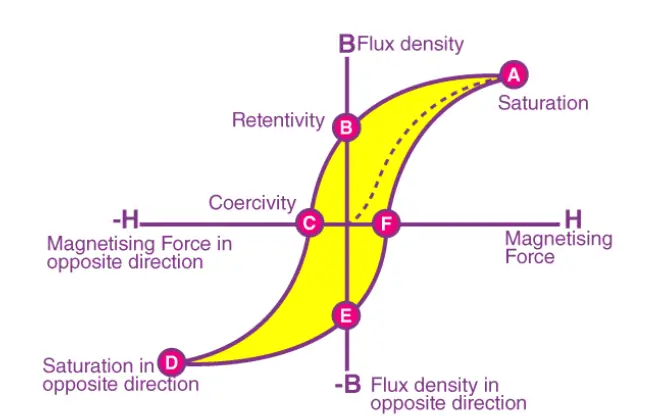Hysteresis is a phenomenon observed in various systems where the response of the system lags behind the changes in the influencing forces. In the context of magnetism, the hysteresis loop is a graphical representation of the relationship between the induced magnetic field (B) and the magnetizing force (H) for a given magnetic material. This loop is critical for understanding the magnetic properties of materials, including coercivity, remanence, and saturation magnetization.
The Hysteresis Loop Explained
A hysteresis loop is typically generated by plotting the magnetic flux density (B) against the magnetizing force (H) as the material is subjected to a cycle of magnetization.

Key Points of the Hysteresis Loop
- Initial Magnetization Curve: When an unmagnetized material is subjected to an increasing magnetizing force (H), the magnetic flux density (B) increases non-linearly until it reaches saturation (Bs).
- Saturation Point: The point at which an increase in H does not result in a significant increase in B is called the saturation point.
- Decreasing H: When the magnetizing force is reduced to zero, the material retains some magnetization (Br), known as the remanent magnetization.
- Coercivity: To demagnetise the material, a negative magnetizing force must be applied. The amount of reverse magnetizing force required to reduce the magnetic flux density to zero is called the coercivity (Hc).
- Negative Saturation: Increasing the reverse magnetizing force further leads to saturation in the opposite direction.
- Loop Closure: As the magnetizing force is cycled back to the positive direction, the loop closes, demonstrating the lag between H and B.
Mathematical Description
The mathematical description of hysteresis can be complex due to its non-linear and path-dependent nature. However, some simplified models, such as the Preisach model and the Jiles-Atherton model, are often used to describe hysteresis in magnetic materials.
Related Concepts
- Remanence: The residual magnetization left in the material when the magnetizing force is reduced to zero.
- Coercivity: The intensity of the applied magnetic field required to reduce the magnetization of the material to zero.
- Saturation Magnetization: The maximum magnetization a material can achieve under an applied magnetic field.
- Magnetic Permeability: The degree to which a material can become magnetized.
- Magnetic Retentivity: The ability of a material to retain magnetization after the external magnetic field is removed.
Applications of Hysteresis Loops
Hysteresis loops are crucial in various technological applications, particularly in the design and functioning of magnetic devices.
- Magnetic Storage
Magnetic materials with well-defined hysteresis loops are used in data storage devices like hard drives and magnetic tapes. These materials store data in the form of magnetic states, which correspond to different points on the hysteresis loop.
- Transformers and Inductors
In power transformers and inductors, the hysteresis loop helps in understanding and minimising energy losses due to magnetic hysteresis. Soft magnetic materials with narrow hysteresis loops are preferred for these applications to reduce energy dissipation.
- Magnetic Sensors
Devices like Hall sensors and magneto-resistive sensors rely on the magnetic properties of materials characterized by their hysteresis loops to detect and measure magnetic fields accurately.
- Electromagnetic Relays
Electromagnetic relays use magnetic materials with specific hysteresis characteristics to ensure reliable switching and holding of the relay contacts.
- Magnetic Hysteresis in Geophysics
Hysteresis loops are used in geophysical studies to understand the magnetic properties of rocks and minerals, which in turn helps in interpreting the Earth’s magnetic history and plate tectonics.
- Hysteresis in Biological Systems
Hysteresis is not limited to magnetic systems; it is also observed in biological systems, such as enzyme kinetics and cellular processes, where the response to stimuli can exhibit hysteresis-like behaviour.
Conclusion
The hysteresis loop is a fundamental concept in understanding the magnetic properties of materials. Its significance spans various fields, from electronic device manufacturing to geophysical explorations. By analysing hysteresis loops, scientists and engineers can tailor materials and devices to optimise performance and efficiency in their respective applications. Understanding hysteresis is thus pivotal in both theoretical studies and practical applications across multiple domains.




